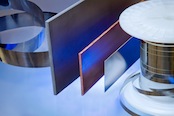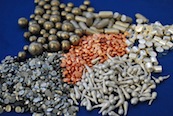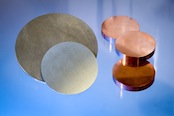Titanium Boride
MATERIAL SAFETY DATA SHEET
I. PRODUCT IDENTIFICATION
Manufacturer/Supplier:
ESPI Metals
1050 Benson Way, Ashland, OR 97520
Toll Free (800) 638-2581 * Fax (541) 488-8313
E-Mail: This email address is being protected from spambots. You need JavaScript enabled to view it.
Product Name: Titanium Boride
Formula: TiB2
CAS Number: 12045-63-5
II. HAZARDOUS INGREDIENTS
Hazardous Component: Titanium Boride *As titanium oxide, boron oxide
Percent (%): 0-100
OSHA/PEL: N/E 10 mg/m3
ACGIH/TLV: N/E 10 mg/m3
HMIS Rating:
Health: 2
Flammability: 0
Reactivity: 2
III. PHYSICAL DATA
Boiling Point: N/E or N/A
Melting Point: 2900 oC
Specific Gravity: 4.50 gm/cc
Solubility in H2O: May react to form B2H6
Appearance and Odor: Grey powder, odorless.
IV. FIRE AND EXPLOSION HAZARDS DATA
Flash Point: N/A
Method Used: Non-flammable
Explosive Limits: Lower: N/A Upper: N/A
Autoignition Temperature: N/A
Extinguishing Media: Use suitable extinguishing media for surrounding materials and type of fire.
Special Fire Fighting Procedures: Firefighters must wear full face self-contained breathing apparatus with full protective clothing to prevent contact with skin and eyes. Fumes from fire are hazardous. Isolate runoff to prevent environmental pollution.
Unusual Fire and Explosion Hazards: When heated to decomposition, titanium boride may emit toxic fumes. On contact with moisture, water or acids it may emit spontaneous flammable hydrides.
V. HEALTH HAZARD INFORMATION
Effects of Over Exposure:
To the best of our knowledge the chemical, physical and toxicological properties of titanium boride have not been thoroughly investigated and recorded. Boron compounds are very toxic and therefore considered an industrial poison. Boron is one of a group of elements, such as Pb, Mn, As, which affects the central nervous system. Boron poisoning causes depression of the circulation, persistent vomiting and diarrhea, followed by profound shock and coma. The temperature becomes subnormal and a scarlatina-form rash may cover the entire body.
Titanium is generally considered to be physiologically inert. There are no reported cases in the literature where titanium as such has caused human intoxication. The dusts of titanium or most titanium compounds such as titanium oxide may be placed in the nuisance category.
Acute Effects:
Inhalation: May cause irritation to the mucous membrane and boron poisoning.
Ingestion: May cause irritation to the gastrointestinal tract and boron poisoning.
Skin: May cause mild irritation.
Eye: May cause mild irritation.
Chronic Effects:
Inhalation: No chronic health effects recorded.
Ingestion: May affect the central nervous system.
Skin: May cause dermatitis.
Eye: No chronic health effects recorded.
Routes of Entry: Inhalation, ingestion.
Target Organs: May affect the central nervous system.
Medical Conditions Generally Aggravated by Exposure: Pre-existing respiratory disorders.
Carcinogenicity: NTP: No IARC: No OSHA: No
EMERGENCY AND FIRST AID PROCEDURES:
INHALATION: Remove victim to fresh air, keep warm and quiet, give oxygen if breathing is difficult and seek medical attention.
INGESTION: If conscious, give 1-2 glasses of milk or water and induce vomiting, seek medical attention. Never give anything by mouth to an unconscious person.
SKIN: Remove contaminated clothing from affected area, brush material off skin, wash affected area with mild soap and water, seek medical attention if symptoms persist.
EYE: Flush eyes with lukewarm water, lifting upper and lower eyelids, for at least 15 minutes. Seek medical attention if symptoms persist.
VI. REACTIVITY DATA
Stability: Stable
Conditions to Avoid: None
Incompatibility (Material to Avoid): Water, moisture and acids.
Hazardous Decomposition Products: Boron oxides at high temperatures.
Hazardous Polymerization: Will not Occur
VII. SPILL OR LEAK PROCEDURES
Steps to Be Taken in Case Material Is Released or Spilled: Wear appropriate respiratory and protective equipment specified in section VIII. Isolate spill area and provide ventilation. Vacuum up spill using a high efficiency particulate absolute (HEPA) air filter and place in a closed container for proper disposal. Take care not to raise dust.
Waste Disposal Method: Dispose of in accordance with all State, Federal and Local regulations.
VIII. SPECIAL PROTECTION INFORMATION
Respiratory Protection (Specify Type): NIOSH approved dust respirator.
Ventilation: Handle in a controlled, enclosed environment, in an inert gas such as argon. Use local exhaust to maintain concentration at low exposure levels. General exhaust is not recommended.
Protective Gloves: Rubber gloves.
Eye Protection: Safety glasses or goggles.
Other Protective Equipment Practices: Protective gear suitable to prevent contamination.
IX. SPECIAL PRECAUTIONS
Precautions to Be Taken in Handling and Storage: Store in a cool, dry area in a tightly sealed container. Wash thoroughly after handling. Titanium boride may react with moisture and water. Handle and store in a controlled environmental and inert gas such as argon.
Other Precautions: Implement engineering and work practice controls to reduce and maintain concentration of exposure at low levels. Use good housekeeping and sanitation practices. Do not use tobacco or food in work area. Wash thoroughly before eating and smoking. Do not blow dust off clothing or skin with compressed air.
Other: Boron is considered an industrial poison. Boron is one of a group of elements, such as Pb, Mn, As, which affects the central nervous system. Boron poisoning causes depression of the circulation, persistent vomiting and diarrhea, followed by profound shock and coma. The temperature becomes subnormal and a scarlatina-form rash may cover the entire body.
Shipping information: Titanium boride is not regulated by the DOT.
Some of the chemicals listed herein are research or experimental substances which may be toxic, as defined by various governmental regulations. In accordance with Environmental Protection Agency regulations and the Toxic Substance Control Act (TSCA), these materials should only be handled by, or under the direct supervision of, a “technically qualified individual”, as defined in 40 CFR 710.2 (aa).
The above information is believed to be correct, but does not purport to be all inclusive and shall be used only as a guide. ESPI shall not be held liable for any damage resulting from handling or from contact with the above product.
Issued by: S. Dierks
Date: July 2003

 ALLOYS
ALLOYS 





